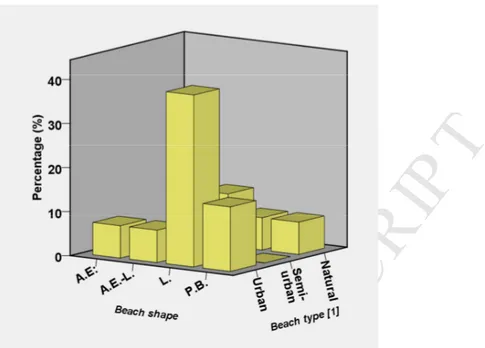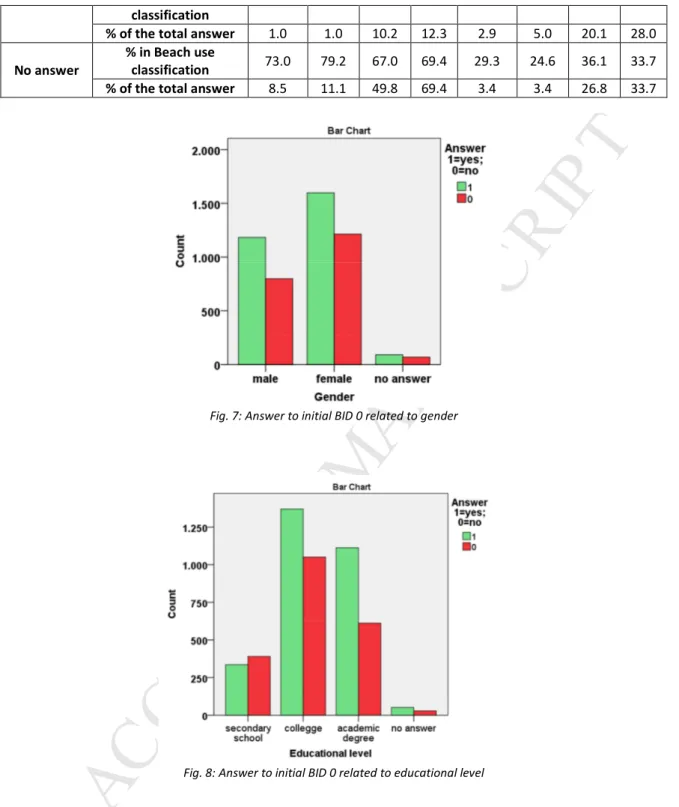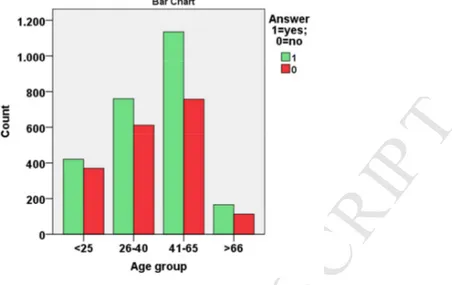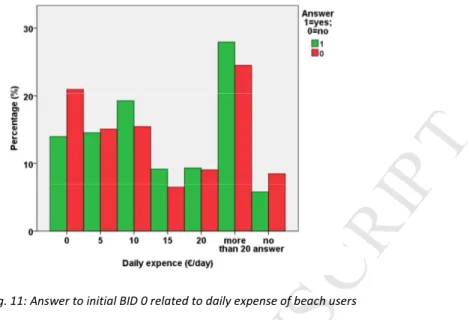Data for the analysis of willingness to pay for Italian beaches
Ilaria Rodella, Fabio Madau, Massimiliano Mazzanti, Corinne Corbau, Donatella Carboni, Kizzi Utizi, Umberto Simeoni
PII: S2352-3409(19)30166-0
DOI: https://doi.org/10.1016/j.dib.2019.103815
Article Number: 103815 Reference: DIB 103815 To appear in: Data in Brief Received Date: 27 January 2019 Revised Date: 26 February 2019 Accepted Date: 27 February 2019
Please cite this article as: I. Rodella, F. Madau, M. Mazzanti, C. Corbau, D. Carboni, K. Utizi, U. Simeoni, Data for the analysis of willingness to pay for Italian beaches, Data in Brief, https:// doi.org/10.1016/j.dib.2019.103815.
This is a PDF file of an unedited manuscript that has been accepted for publication. As a service to our customers we are providing this early version of the manuscript. The manuscript will undergo copyediting, typesetting, and review of the resulting proof before it is published in its final form. Please note that during the production process errors may be discovered which could affect the content, and all legal disclaimers that apply to the journal pertain.
M
AN
US
CR
IP
T
AC
CE
PT
ED
Data article
Title:Data for the analysis of willingness to pay for Italian beaches
Authors:
Ilaria Rodella1, Fabio Madau2, Massimiliano Mazzanti3, Corinne Corbau4, Donatella Carboni5, Kizzi Utizi4, Umberto Simeoni4
Affiliations:
1
Department of Engineering, Ferrara University, via Saragat 1, 44122 Ferrara, Italy. 2
Department of Science for Nature and Environmental Resources, Sassari University, via Enrico de Nicola 1, 07100 Sassari, Italy.
3
Department of Economics and Management, Ferrara University, via Voltapaletto 11, 44121 Ferrara, Italy.
4
Department of Physics and Earth Sciences, Ferrara University, via Saragat 1, 44122 Ferrara, Italy. 5
Department of Human and Social Sciences, Sassari University, via Roma151, 07100 Sassari, Italy.
Contact email:
Ilaria Rodella, Department of Engineering, Ferrara University, via Saragat 1, 44122 Ferrara,
Italy, E-mail address [email protected]
Abstract
The data presented herein relates to the article entitled “Willingness to pay for management and preservation of natural, semi-urban and urban beaches in Italy” [1].
Data of several Italian beaches are collected considering shape, anthropogenic characteristics, use, activity and urbanization levels. Descriptive statistics of beach characteristics and beach users are presented, on the basis of about 5,000 interviews.
Specifications Table
Subject area Earth Science - Economics More specific subject area Coastal management Type of data Table and graph How data was acquired Survey
Data format Analyzed
M
AN
US
CR
IP
T
AC
CE
PT
ED
(residency, age, sex, education, income).
Experimental features The relationship between beach features, demographic characteristics and the Willingness to Pay (WTP) of beach-goers were determined.
Data source location Data are available for forty-one localities of eleven regions in Italy (see also Supplementary material 1 and interactive kmz map):
1. Lido di Venezia, Rosolina Mare (Veneto region)
2. Lido di Nazioni, Lido di Pomposa, Lido degli Scacchi, Porto Garibaldi (Emilia-Romagna region)
3. Porto Recanati, Civitanova Marche, Porto Sant'Elpidio, San Benedetto Del Tronto (Marche region)
4. Manfredonia, Mattinata, Margherita Di Savoia, Trani, Bisceglie, Mola Di Bari, Bari, Monopoli, Ostuni-Costa Merlata, Fasano, Castellaneta Marina, Gallipoli, Salve, Ugento (Apulia region)
5. Metaponto Lido (Basilicata region)
6. Capopiccolo-Isola Capo Rizzuto, Isola Capo Rizzuto, Le Castella Isola Capo Rizzuto, Bagnara Calabra (Calabria region)
7. Pozzallo (Sicily region)
8. Scoglio Lungo, Fiume Santo, Lido San Giovanni, Le Bombarde (Sardinia region)
9. Battipaglia, Eboli, Capaccio (Campania region) 10. Follonica, Cecina, Pietrasanta (Tuscany region) 11. Lavagna (Liguria region)
Data accessibility With this article
Related research article Rodella I., Madau, F., Mazzanti, M., Corbau, C., Carboni, D., Utizi, K., Simeoni, U., 2019. Willingness to pay for management and preservation of natural, semi-urban and urban beaches in Italy. Ocean Coast Manag 172,93:104. doi: 10.1016/j.ocecoaman.2019.01.022 [1]
Value of the data
• WTP literature review may be useful as reference data for future studies on economic value of beaches;
• These data could be useful in comparing beach classifications of Mediterranean beaches;
• Data were collected in such a way as to obtain beach users’ willingness to pay (WTP). These data may thus be useful to researchers comparing users’ WTP in different beach typologies.
Data
This dataset presents information on: WTP studies in coastal management, Italian beach characteristics and classifications, WTP and some demographic beach users’ statistics. Beach characteristics are used as variables in a multivariate model of WTP [1].
M
AN
US
CR
IP
T
AC
CE
PT
ED
Supplementary material 1, from Fig. 1 to Fig. 5 graphs report data about beach characteristics and typologies of the case studies. Fig. 6 shows the questionnaires distribution for each beach type. The results from this dataset are presented in [1].
From Table 1 to Table 3 and from Fig. 7 to Fig. 11 data present correlations between WTP and some demographic characteristics of beach users.
Fig. 1: Selected beaches classified by shape
M
AN
US
CR
IP
T
AC
CE
PT
ED
Fig. 3: Selected beaches classified by Activity classification [2]
M
AN
US
CR
IP
T
AC
CE
PT
ED
Fig. 5: Correspondence between beach shape and beach use characteristics (A.E.: artificial embayed beach; A.E.-L.: artificial embayed beach-linear; L.: linear beach; P.B.: pocket beach)
Experimental Design, Materials and Methods
Researchers collected these data by in-person collection of questionnaires from visitors and residents to Italian beaches (Interactive map data). A questionnaire was used to elicit visitor preferences and
willingness to pay for coastal preservation. The questionnaire was based on those used by [3] and [4] and was structured in sections (Supplementary material 2). Data were collected from June to September 2015. Only people over 16 years old were randomly selected and interviewed. In the case of a group visit, one person was interviewed in order to avoid the risk of doubling answers. They were also
informed that there was no right or wrong answer and their sincere responses would be appreciated [1]. [5] presents single case studies of Italian beaches, while in this manuscript the overall national point of view is elaborated.
Statistical and descriptive analyses of WTP surveys were performed using the Statistical Package for Social Sciences (SPSS) version 20 (Statistics Solutions) and Microsoft Excel version 2017 (Microsoft Office, Redmond, Washington, USA).
M
AN
US
CR
IP
T
AC
CE
PT
ED
Fig. 6: Questionnaire distribution in different beach typology defined by [1]
Table 1: Distribution of WTP response in the DB CVM:BID 0 (Pearson chi-square value= 176,857;degree of freedom=4; p-value=0.000)
BID 0 (€) Yes (%) No (%) Total (%)
0 0.3 0.2 0.5 2 17.5 8.1 25.5 5 15.8 8.7 24.4 10 13.0 10.7 23.8 20 11.4 14.3 25.8 Total 58.0 42.0 100
Table 2: Distribution of WTP response in the DB CVM: BID 1 (Pearson chi-square value= 682,754;degree of freedom=28; p-value=0.000)
BID 1 (€) Yes (%) No (%) Total (%)
1 1.5 6.6 8.1 2.5 1.9 6.7 8.6 4 12.7 5.2 17.9 5 3.2 7.7 10.9 10 13 16.8 29.8 20 5.2 7.6 12.7 40 3.3 8.2 11.5 Total 40.8 58.7 99.5
Table 3: Results of resident and tourist WTP (Pearson chi-square value= 6.377;degree of freedom=2; p-value=0.041)
Answer % per category
RESIDENTS WTP (%) TOURISTS WTP (%)
natural
semi-urban urban Total natural
semi-urban urban Total Yes
% in Beach use
classification 18.,0 13.4 18.2 17.5 45.7 40.0 36.5 38.1
% of the total answer 2.1 1.9 13.5 17.5 5.3 5.6 27.1 38.1
M
AN
US
CR
IP
T
AC
CE
PT
ED
classification% of the total answer 1.0 1.0 10.2 12.3 2.9 5.0 20.1 28.0
No answer
% in Beach use
classification 73.0 79.2 67.0 69.4 29.3 24.6 36.1 33.7
% of the total answer 8.5 11.1 49.8 69.4 3.4 3.4 26.8 33.7
Fig. 7: Answer to initial BID 0 related to gender
M
AN
US
CR
IP
T
AC
CE
PT
ED
Fig. 9: The percentage of answer to initial BID 0 related to beach users age
M
AN
US
CR
IP
T
AC
CE
PT
ED
Fig. 11: Answer to initial BID 0 related to daily expense of beach users
Acknowledgements
Data collection are supported by the National Research Group for Coastal Environment issues (GNRAC), in particular the president Pr. Enzo Pranzini, the Department of Physics and Earth Science of the University of Ferrara and Legambiente, in particular Dr. Giorgio Zampetti, Dr. Giancarlo Chiavazzo, Dr. Natalia Carpanzano and Dr. Antonino Duchi. Authors also thank Dr. Alessio Acciarri, Pr. Pierluigi Brandolini, Dr. Maria Caldarola, Pr. Nicola Corradi, Pr. Leonardo Damiani, Dr. Cristina Ghiagheddu, Dr. Irene Mammì, Dr. Enrica Mori, Dr. Gabriele Lami, Dr. Mattia Menegatti, Dr. Luigi Parente, Dr. Stefano Paganin, Dr. Gianfranco Spina Iaconis, Dr. Antonio Trivisani.
Transparency document. Supplementary material
Supplementary material 1: Main beach characteristics and typologies Supplementary material 2: The questionnaire
Supplementary material 3: Literature review about WTP in coastal management
Interactive map data
The selected beaches (kmz file)
References
[1] Rodella I., Madau, F., Mazzanti, M., Corbau, C., Carboni, D., Utizi, K., Simeoni, U., 2019. Willingness to pay for management and preservation of natural, semi-urban and urban beaches in Italy. Ocean Coast Manag 172,93:104. doi: 10.1016/j.ocecoaman.2019.01.022
M
AN
US
CR
IP
T
AC
CE
PT
ED
[2] Williams, A.T., Micallef, A., 2009. Beach Management principles and practice. London. [3] Rodella, I., Corbau, C., Simeoni, U., Utizi, K., 2017. Assessment of the relationship between
geomorphological evolution, carrying capacity and users perception: Case studies in Emilia-Romagna (Italy). Tour. Manag. 59, 7–22. doi:10.1016/j.tourman.2016.07.009
[4] Simeoni, U., Corbau, C., Rodella, I., 2017. La percezione dell’offerta turistico-balneare in Italia: aspettative, soddisfazione e conoscenze degli aspetti fisico-gestionali delle spiagge. Studi Costieri 25, 5–24.http://www.gnrac.unifi.it/rivista/Numero25/Articolo1.pdf
[5] GNRAC, 2017. Il turista e il suo giudizio sulle spiagge italiane. Ilaria Rodella, Corinne Corbau, Kizzi Utizi Eds. Studi Costieri, 25, pp. 146 http://www.gnrac.unifi.it/rivista/Numero25.htm
![Fig. 2: Selected beaches classified by Anthropogenic classification [2]](https://thumb-eu.123doks.com/thumbv2/123dokorg/4737658.46366/4.892.201.745.270.967/fig-selected-beaches-classified-anthropogenic-classification.webp)
![Fig. 3: Selected beaches classified by Activity classification [2]](https://thumb-eu.123doks.com/thumbv2/123dokorg/4737658.46366/5.892.213.748.161.1028/fig-selected-beaches-classified-activity-classification.webp)




